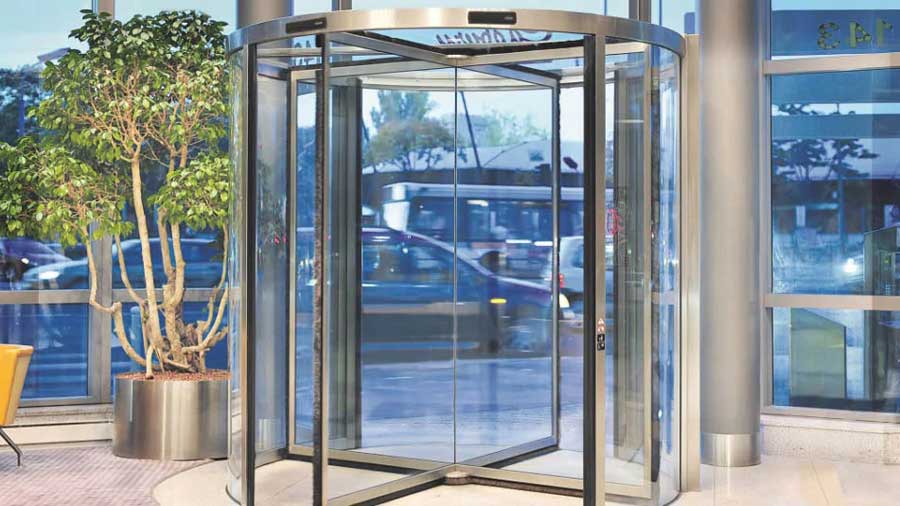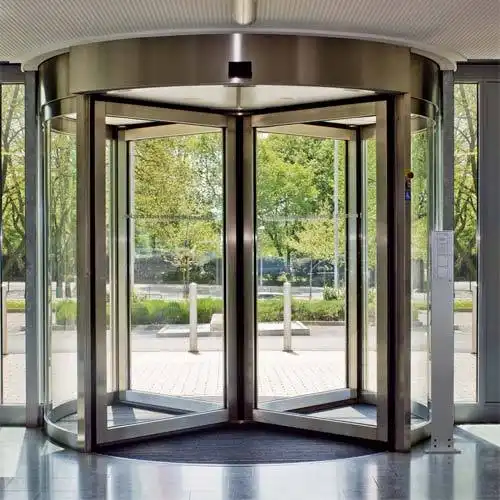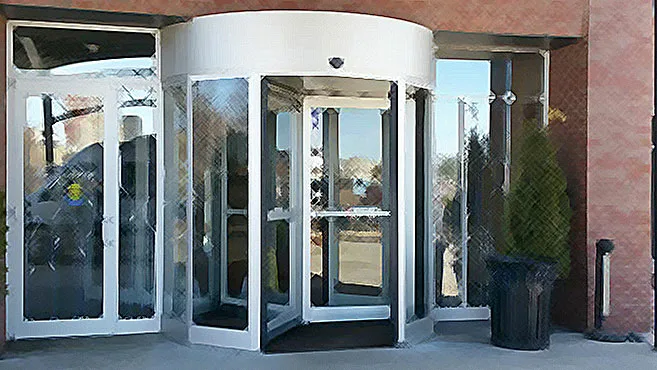An automatic revolving door is a motorized entrance system equipped with rotating panels that open smoothly when sensors detect movement. It allows hands-free access while regulating airflow to maintain indoor temperatures and improve energy efficiency. Designed for safety and efficiency, its continuous rotation ensures a steady flow of people, preventing congestion in busy areas.
A revolving automatic door consists of several key components that ensure smooth and efficient operation:
- Central Shaft & Rotating Mechanism – The core structure that supports and rotates the door panels.
- Door Wings/Panels – Typically three or four, these panels form the rotating sections that create compartments for entry and exit.
- Motor & Drive System – Powers the rotation and controls the speed for safe and smooth movement.
- Motion Sensors – Detect approaching users and activate the door’s rotation automatically.
- Speed Control & Safety Sensors – Regulate rotation speed and prevent accidents by detecting obstructions.
- Canopy & Housing – The overhead structure that encloses the mechanical components and provides structural support.
- Night Locking Mechanism – Secures the door when not in operation to prevent unauthorized access.
- Brush Seals & Weather Strips – Minimize air leakage and help maintain indoor temperature control.

Applications of Automatic Revolving Doors
- Commercial Buildings – Offices, corporate headquarters, and business centers for controlled access and energy efficiency.
- Hotels & Resorts – Enhances guest experience with seamless entry and exit.
- Shopping Malls & Retail Stores – Manages high foot traffic while maintaining indoor climate control.
- Airports & Transportation Hubs – Ensures smooth passenger movement and security.
- Hospitals & Healthcare Facilities – Provides touch-free access, improving hygiene and accessibility.
- Government & Institutional Buildings – Enhances security and operational efficiency.
- Banks & Financial Institutions – Combines security with ease of entry for customers.
- Educational Institutions – Used in universities and research centers for controlled entry.
- Luxury Apartments & Residential Towers – Adds convenience and a modern aesthetic to entrances.
- Museums & Cultural Centers – Preserves indoor conditions while managing visitor flow.
Advantages of Automatic Revolving Doors
- Uses motion or infrared sensors to detect approaching users and activate rotation.
- Automatically adjusts speed for smooth and safe movement.
- Stops or slows down in case of obstruction to prevent accidents.
- Allows manual override or automatic halt during emergencies.
- Compatible with keycard, biometric, or RFID systems for restricted entry.
- Can be locked in a closed position for after-hours security.
- Features a slow-motion mode or push-button control for accessibility.
- Provides insulation against wind, rain, and temperature fluctuations.
- Available in various materials, finishes, and glass types.
- Can integrate with fire alarm systems for automatic disengagement if required.
Materials Used in Automatic Revolving Doors
- Aluminum – Lightweight, corrosion-resistant, and commonly used for frames.
- Stainless Steel – Strong, durable, and ideal for high-traffic areas.
- Glass – Clear, tinted, or laminated for visibility, aesthetics, and insulation.
- Bronze/Brass – Used for premium or decorative finishes.
- Wood – Occasionally used for custom or heritage designs.
- Polycarbonate – Impact-resistant and lightweight alternative to glass.
- Rubber & Brush Seals – Used for waterproofing and insulation.

Types of Automatic Revolving Doors
- Three-Wing Revolving Doors- Three-wing revolving doors have large entry compartments, allowing smooth pedestrian movement while balancing accessibility and energy efficiency. Their spacious design accommodates users carrying luggage or strollers, making them ideal for commercial buildings, hotels, and office spaces where controlled air circulation and reduced energy loss are priorities.
- Four-Wing Revolving Doors- Four-wing revolving doors feature smaller entry compartments, ensuring faster and more efficient pedestrian movement. The additional wing enhances air control, preventing outdoor air from entering the building. Commonly installed in high-traffic areas like shopping malls, airports, and corporate headquarters, these doors improve energy performance while optimizing crowd flow.
- Full-Glass Revolving Doors- Full-glass revolving doors offer a sleek, modern aesthetic with frameless glass panels that maintain openness while ensuring insulation. Designed to blend with contemporary architecture, they are frequently found in luxury hotels, corporate offices, and high-end commercial spaces where aesthetics and energy efficiency are equally important.
- Framed Revolving Doors- Framed revolving doors feature metal or aluminum structures that enhance durability and provide additional strength. The reinforced design makes them suitable for high-traffic environments such as hospitals, government offices, and industrial facilities. These doors offer a balance of structural stability and professional appearance while ensuring longevity in demanding settings.
- Security Revolving Doors- Security revolving doors incorporate access control technologies like biometric scanners, RFID keycards, or facial recognition to regulate entry. They prevent unauthorized access and are ideal for banks, data centers, and corporate offices where security is a primary concern. Some models include bullet-resistant glass and remote monitoring for enhanced protection.
- Automatic Hybrid Revolving Doors- Hybrid revolving doors combine revolving, sliding, or swing functionalities to suit different access needs. They can switch modes based on traffic conditions or user requirements, offering greater flexibility. These doors are commonly used in hospitals, airports, and public buildings, where adaptable entry solutions enhance accessibility and convenience.
- Small-Diameter Revolving Doors- Small-diameter revolving doors provide an effective entry solution for buildings with limited entrance space. Despite their compact design, they maintain the same benefits as larger models, such as energy efficiency and controlled airflow. These doors are ideal for boutique hotels, small offices, and historical buildings with restricted entryways.
- Weather-Resistant Revolving Doors- Weather-resistant revolving doors are built to withstand extreme climate conditions, featuring insulated glass, reinforced sealing, and durable materials. They prevent air leakage, minimize temperature fluctuations, and improve energy efficiency. Commonly used in cold climates, coastal areas, and energy-conscious commercial properties, these doors enhance indoor comfort while reducing heating and cooling costs.

Factors to Consider for Selecting the Right Automatic Revolving Doors
- Consider foot traffic volume and accessibility needs.
- Choose the right diameter, height, and wing design.
- Look for emergency stops, obstruction sensors, and fire compliance.
- Opt for security integrations like RFID, keycard, or biometric systems.
- Ensure proper insulation, weather sealing, and low-energy operation.
- Check for night security mode and controlled entry options.
- Select sturdy materials that match the building’s aesthetics.
- Consider clear, tinted, or laminated glass for privacy and safety.
- Choose a model with quiet and controlled operation.
- Look for easy upkeep and self-diagnosing systems.
Conclusion
Automatic Revolving Doors offer seamless entry, security, and energy efficiency, making them ideal for various applications. With different types catering to specific needs, they enhance accessibility, control airflow, and improve crowd management, providing a reliable solution for modern buildings.


